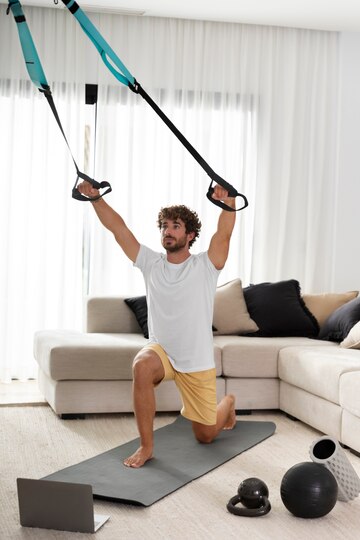1. Assess Your Space
Before purchasing equipment, evaluate the space you have available. Whether it’s a spare room, basement, or garage, understanding the dimensions and layout of your area will help you choose the right equipment and design your gym efficiently.
- Measure the Area: Determine the available space and make a layout plan to ensure you can accommodate all necessary equipment.
- Consider Flooring: Choose flooring that is both durable and easy to clean. Rubber mats or foam tiles are ideal for absorbing impact and protecting your floors.
2. Choose the Right Equipment
Selecting the right equipment is crucial for a well-rounded workout. Focus on versatility and quality to get the most out of your home gym.
- Cardio Machines: Treadmills, stationary bikes, and ellipticals are excellent for cardiovascular workouts. Choose one that fits your fitness goals and space.
- Strength Training Equipment: Invest in dumbbells, resistance bands, and a set of kettlebells for strength training. A multi-functional weight bench can also add variety to your workouts.
- Functional Training Gear: Incorporate items like a stability ball, medicine balls, and a jump rope for functional training exercises.

3. Create a Motivating Environment
The right environment can make a significant difference in your workout motivation and overall experience.
- Lighting: Ensure good lighting in your gym area. Natural light is ideal, but adjustable lighting can help set the mood for different types of workouts.
- Ventilation: Good airflow is important for comfort during intense workouts. Consider a fan or air purifier to keep the space cool and fresh.
- Decor and Inspiration: Add motivational posters or quotes to inspire you. Keep the space clean and organized to create a positive and inviting workout environment.
4. Incorporate Technology
Integrating technology can enhance your workouts and provide valuable feedback on your progress.
- Fitness Apps: Use fitness apps to track your workouts, monitor progress, and access workout routines. Many apps offer virtual classes and guided exercises.
- Smart Equipment: Consider investing in smart fitness equipment that tracks your performance and provides real-time feedback.
- Entertainment: Set up a sound system or TV to enjoy music, podcasts, or workout videos while exercising.
5. Ensure Safety and Accessibility
Safety is a top priority when setting up your home gym. Make sure your space is safe and accessible for all users.
- Clear Pathways: Keep walkways and exits clear to prevent accidents. Avoid clutter and ensure that all equipment is set up correctly.
- Proper Use: Familiarize yourself with the correct use of each piece of equipment to avoid injury. If needed, watch instructional videos or consult a fitness professional.
- Emergency Preparedness: Keep a first aid kit accessible and know basic first aid procedures in case of minor injuries.
6. Budget Smartly
Creating a home gym doesn’t have to break the bank. Prioritize your purchases based on your budget and fitness goals.
- Start Small: Begin with essential equipment and gradually add more items as needed. This approach allows you to manage costs and evaluate what works best for you.
- Look for Deals: Watch for sales, discounts, and second-hand options for high-quality equipment at lower prices.
- Invest Wisely: Focus on investing in durable, high-quality equipment that will last longer and provide better performance.
7. Set Up a Workout Routine
Having a well-structured workout routine can help you stay consistent and motivated.
- Create a Schedule: Plan your workouts in advance and set a consistent schedule to build a routine. Incorporate a mix of cardio, strength training, and flexibility exercises.
- Track Progress: Keep a workout journal or use an app to track your progress and adjust your routine as needed.
Ready to set up your own home gym and take your fitness to the next level? Start with the essentials and create a space that motivates and inspires you. Contact local fitness equipment suppliers or consult with a fitness professional to get personalized recommendations and kickstart your gym with our in-home personal trainer Houston journey today!
FAQs About Setting Up a Home Gym
1. What equipment do I need to start a home gym?
Essential equipment includes dumbbells, resistance bands, a weight bench, a cardio machine (like a treadmill or stationary bike), and functional training tools such as a stability ball or jump rope.
2. How much space do I need for a home gym?
The space needed depends on the equipment you choose and how many users will be working out at once. Measure your available space and plan accordingly to ensure you have enough room for safe and effective workouts.
3. How can I make my home gym motivating?
Create a motivating environment with good lighting, ventilation, and inspiring decor. Incorporate technology like fitness apps and entertainment systems to keep you engaged and motivated.
4. How can I ensure the safety of my home gym?
Ensure clear pathways, familiarize yourself with equipment use, and keep a first aid kit handy. Regularly inspect equipment for maintenance and follow safety guidelines for each piece of gear.
5. Is it necessary to invest in expensive equipment for a home gym?
No, you can start with basic, affordable equipment and gradually add more items as needed. Focus on quality and durability to get the best value for your investment.
